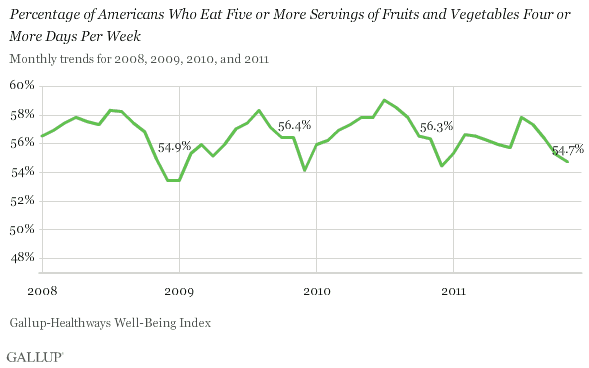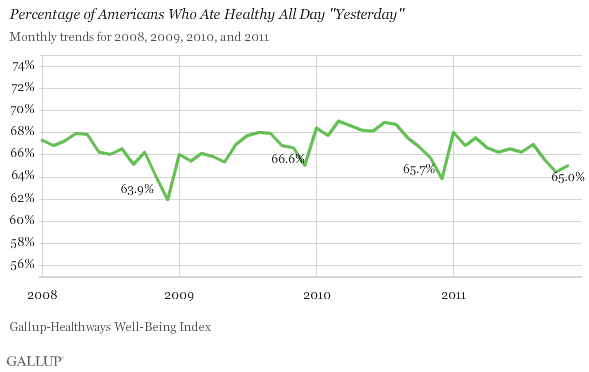WASHINGTON, D.C. -- As is typical during the winter season, Americans report exercising less. The percentage of adults who reported exercising frequently -- for at least 30 minutes three or more days per week -- fell to 49.8% in November, from 52.2% in October and from the year's high of 54.5% in July. Fewer Americans exercised frequently last month than did in November of last year (50.5%).

Americans typically exercise more in the spring and summer and less in the fall and winter. Frequent exercise usually drops to its lowest point in December of each year and beings to improve again in January.
The percentage of Americans reporting that they exercise frequently was relatively low through the fall of 2008 and much of 2009, amid the worst of the economic crisis. However, the percentage who reported frequent physical activity was generally higher in 2010 and has since remained at somewhat higher levels. The average percentage of Americans who exercised frequently was 51.5% in 2010, 49.6% in 2009, and 51.4% in 2008.
Gallup and Healthways ask 1,000 American adults daily about their exercise habits as part of the Gallup-Healthways Well-Being Index. The Gallup-Healthways Well-Being Index also measures Americans' daily eating habits and finds a similar seasonal pattern.
The percentage of Americans reporting that they frequently eat fruits and vegetables, or five or more servings at least four days per week, was 54.7% in November, compared with 55.2% in October -- down from a high of 57.8% in July.
In November, the percentage of Americans who reported eating fruits and vegetables frequently was the lowest recorded for that month in any prior year, including in November 2008 during the financial crisis. In fact, fewer Americans consumed fruits and vegetables frequently in every month but one this year compared with last year.

A separate question which asks Americans if they ate healthy all day "yesterday" also follows a similar seasonal trend and is down in November compared with the spring and summer months. Like produce consumption, the percentage of Americans reporting they ate healthy the entire day prior to the survey is down compared with 2010 and 2009.

Concurrently with people consuming less produce and eating less healthy in 2011, more Americans are struggling to afford food. This could be the result of Americans cutting back on healthier food items, such as fresh produce, that can be more expensive. Gallup reported that the percentage of Americans who lacked money to buy food had been declining since April. In October, that percentage fell to a level close to the November 2008 record low. Additionally, Gallup's global polling has found more Americans are now struggling to afford food than are Chinese, a change from 2008 when the opposite was true.
Bottom Line
Each fall and winter, Americans' exercise and eating habits start to go downhill and decline to their lowest levels for the year every December. The percentage of Americans who exercise and consume fruits and vegetables frequently falls about five percentage points every December from the highs Gallup finds each July and August. These decreases translate to millions fewer Americans getting the exercise and healthy foods they need for several months each year. Many factors may be contributing to this seasonal trend such as increasing difficulty exercising outside during the colder winter months and decreasing access to fresh produce available in stores.
However, for a country already grappling with high levels of obesity and chronic disease, improving good health habits year round is a critical challenge. In particular, with an increasing number of Americans struggling to afford food, government and business leaders may need to work to improve access to grocery items such as fresh fruits and vegetables.
About the Gallup-Healthways Well-Being Index
The Gallup-Healthways Well-Being Index tracks well-being in the U.S., U.K., and Germany and provides best-in-class solutions for a healthier world. To learn more, please visit well-beingindex.com.
Survey Methods
Results are based on telephone interviews conducted as part of the Gallup-Healthways Well-Being Index survey Nov. 1-30, 2011, with a random sample of 29,285 adults, aged 18 and older, living in all 50 U.S. states and the District of Columbia, selected using random-digit-dial sampling.
For results based on the total sample of national adults, one can say with 95% confidence that the maximum margin of sampling error is ±1 percentage point.
Interviews are conducted with respondents on landline telephones and cellular phones, with interviews conducted in Spanish for respondents who are primarily Spanish-speaking. Each sample includes a minimum quota of 400 cell phone respondents and 600 landline respondents per 1,000 national adults, with additional minimum quotas among landline respondents by region. Landline telephone numbers are chosen at random among listed telephone numbers. Cell phone numbers are selected using random-digit-dial methods. Landline respondents are chosen at random within each household on the basis of which member had the most recent birthday.
Samples are weighted by gender, age, race, Hispanic ethnicity, education, region, adults in the household, and phone status (cell phone only/landline only/both, cell phone mostly, and having an unlisted landline number). Demographic weighting targets are based on the March 2010 Current Population Survey figures for the aged 18 and older non-institutionalized population living in U.S. telephone households. All reported margins of sampling error include the computed design effects for weighting and sample design.
In addition to sampling error, question wording and practical difficulties in conducting surveys can introduce error or bias into the findings of public opinion polls.
For more details on Gallup's polling methodology, visit www.gallup.com.
